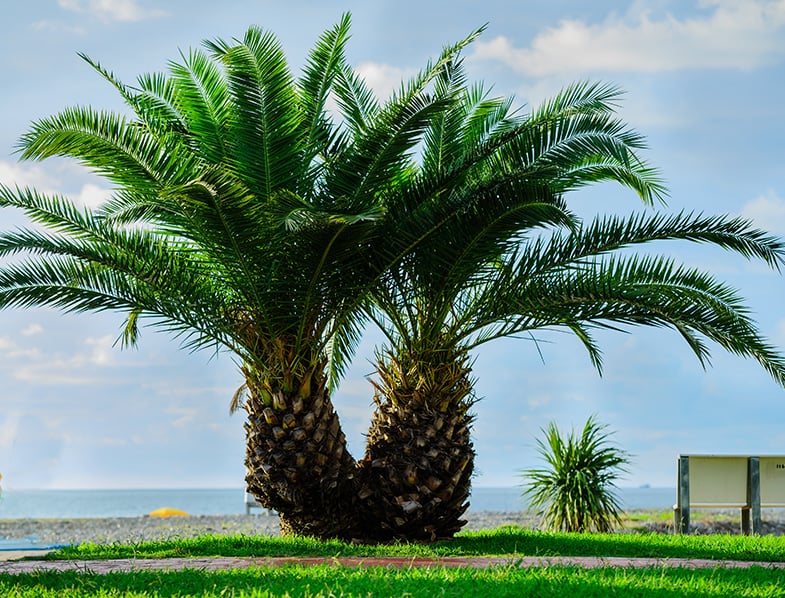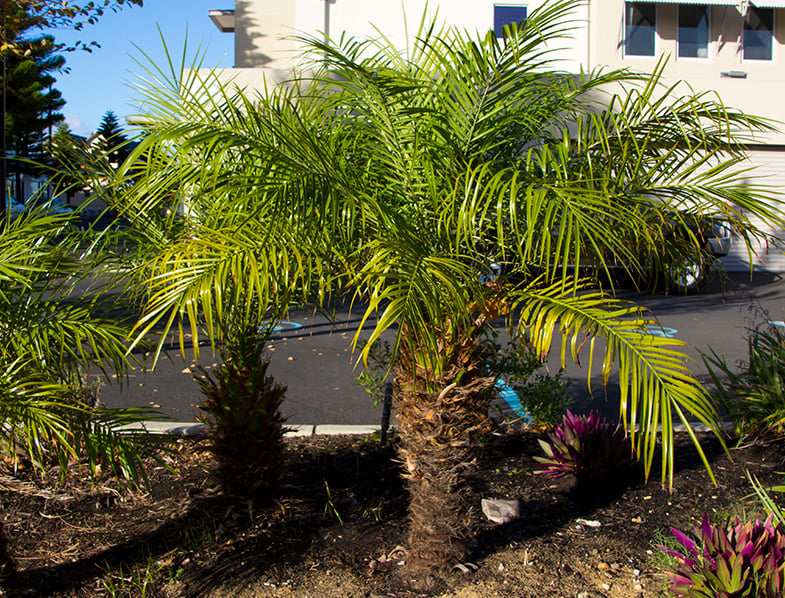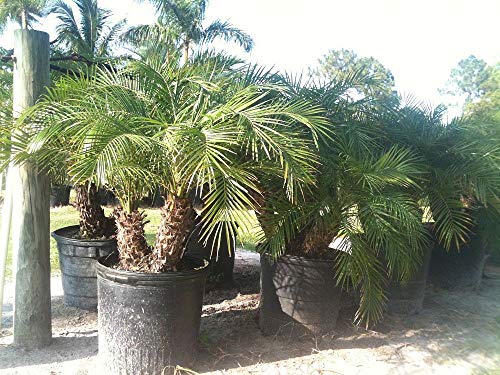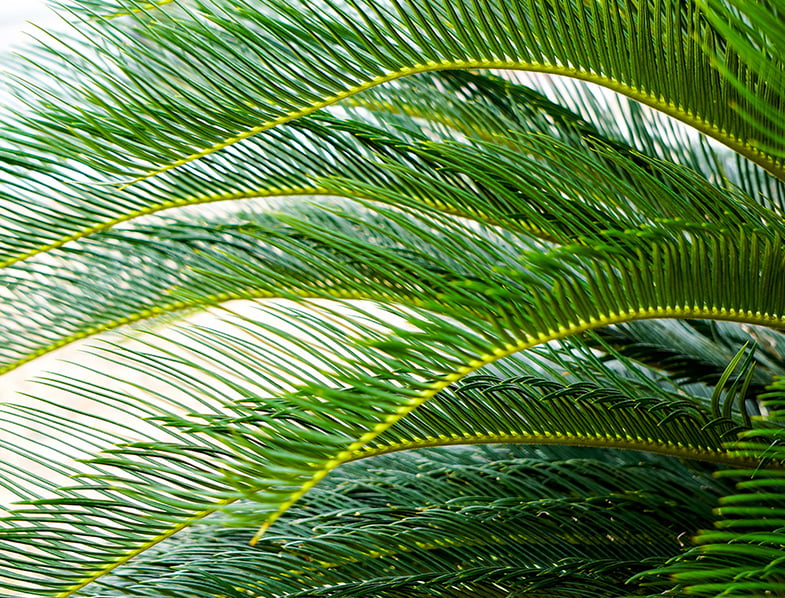There is something magical about growing a tree inside your house. If you are looking for an attractive tree that will fit indoors, the Pygmy Date Palm Tree is an interesting option to consider.
This handsome tropical plant has soft leaflets that add an attractive touch of nature to any area. Watch out though, it grows sharp spines along the bottom of the fronds so if you have small kids or curious pets, you may want to reconsider your houseplant choice. As a native of South Asia, the Pygmy Date Palm Tree loves tropical or humid climates such as those found in Florida and other Southern states.
Like most houseplants, you will need to keep an eye out for scale bugs and aphids. Aside from these two critters, the Pygmy Date Palm Tree doesn’t tend to attract pest. This low maintenance plant is a great option for property owners who are looking to improve the look of their interior without committing to a heavy workload.
As a pro tip, make sure you are buying the right plant when purchasing from a nursery or gardening store. Instead of asking for a Pygmy Date Palm Tree, ask for its species name, the Phoenix roebelenii.
Pygmy Date PalmQuick Facts
| Category | Information |
|---|---|
| Common Name | Pygmy Date Palm, Dwarf Date Palm |
| Botanical Name | Phoenix roebelenii |
| Native to | South Asia |
| Climate | Tropical or humid climates |
| Appearance | Slow-growing with arching fronds and sharp spines |
| Height | Up to 10 feet with proper care |
| Maintenance | Low maintenance, requires proper soil moisture, and occasional fertilizer |
| Propagation | Can be propagated from suckers or seeds |
| Care Tips | Needs humid environment and indirect sunlight, rinse foliage occasionally with warm water |
| Caution | Sharp spines can be dangerous for small children and pets |
| Pest | Attracts scale bugs and aphids, but not many other pests |
About the Pygmy Date Palm
- The Phoenix roebelenii is a slow-growing tropical plant.
- Once the Pygmy Date Palm reaches maturity, it can reach the height of several feet.
- The fronds of the tree are arching, long leaflets.
- Sharp spines grow at the base of each of the tree fronds.
- This palm needs special micronutrients, specifically, magnesium.
Pygmy Date Palm Features: An Overview
- The Pygmy Date Palm has a botanical name of Phoenix roebelenii.
- Once mature, the Phoenix roebelenii will have a width of about four feet.
- Most palms have a look of plastic, this species however has soft leaflets.
- As a Southeastern Asia native, the Pygmy Date Palm Tree loves humid conditions.
- Pygmy Date Palm Trees are also known as the Dwarf Date Palm.
- The plant should be checked for scale bugs on the fronds and midrib often.
- When cultivated indoors, the plant can reach a height of up to seven feet.

Growing The Pygmy Date Palm
Growing the Pygmy Date Palm is not complicated. It needs a humid environment and plenty of space to mature. Depending on where you live you may need to mist your plant or use a humidifier to maintain proper moisture levels.
If there is not enough moisture in the air, the tips of the leaves may start to turn brown and wither. The Phoenix roebelenii is a tropical plant and love light as a result. Make sure that you expose your tree to plenty of sun, but just ensure that it is indirect. Consider placing your Phoenix roebelenii in a room that features an East-facing window and turn the plant each week for even exposure.
The Pygmy Date Palm Tree grows about as fast as a regular tree and should be moved into a bigger container every few years. It is best to only change its pot in the spring and once it matures you will only need to refresh the first few soil layers.
Once the Pygmy Date Palm Tree has reached maturity you will no longer be able to change pots. The root system of this plant is very sensitive to changes. The plant also tends to be heavier on the top with a thin trunk. Use a heavy base such as a ceramic or specialized brass container to keep it from tipping.
If you plant to grow your tree outdoors, make sure it is in a shaded but well-lit area. Extreme heat and cold is not healthy for a palm, so consider your planting options wisely. Once established, the Pygmy Date Palm Tree can’t be moved.

Watering The Pygmy Date Palm
Watering your Phoenix roebelenii is much simpler than most houseplants. It just needs to maintain moist soil during the warmer months and slightly dry soil in the winter. Use a well-draining soil that doesn’t collect water to prevent standing water and root rot. Proper drainage is critical for proper cultivation and development.
As with most tropical plants, the Phoenix roebelenii loves humid climates. Anything around 50% is ideal, but if you live in a dryer climate you can sit the dwarf date palm on a tray of watered pebbles. You can also install a cool-mist room humidifier to maintain proper moisture levels instead.
Watering the plant once a week is usually enough to ensure proper moisture, but it is important that you check the dryness of the soil first. Overwatering can lead to root rot, so make sure at least two inches of soil is dry before watering it again.
You can also use a moisture meter if you prefer not to eyeball the levels or use a finger test. Your planter should also have drainage holes that you can empty after watering, or you can place it on top of pebbles to maintain humidity levels. A little bit of occasional dryness is well-tolerated, but constant dryness may cause plant failure.

Phoenix roebelenii, Pygmy Date Palm, From Amazon
Propagating The Pygmy Date Palm
Propagating your dwarf date palm is easier than most house plants. As your existing tree begins to mature, it will grow suckers along the base of the tree. During the spring, cut these suckers while also maintaining the roots of the cuts. Pot them in a new container of fresh soil. You can also propagate the dwarf date palm from seeds, but expect this process to take much longer than using a dwarf date palm sucker cutting.
The idea temperature for new saplings and mature plants alike falls between 65 degrees and 85 degrees. In the winter, make sure that the room does not fall below 55 degrees or you may find that your tree does not survive. Plant your dwarf date palm suckers in a fresh soil that is a mix of well-draining potting soil and perlite. You can also use a standard potting mix with horticulture sand as well.

Feeding the Phoenix roebelenii is pretty easy, you only need to give it a palm specific fertilizer a most three times per year. This will ensure it gets the right nutrients for its species. Specifically, Phoenix roebelenii needs a proper mix of, phosphorous, magnesium, nitrogen, and potassium.
Keep your Phoenix roebelenii plants protected from strong drafts and direct sunlight until they have fully matured. For indoor plants, keep them out of the direct line of airflow that comes from vents, fans, and doors. If you plan to take your plant outside during good weather, make sure it is sheltered from extreme heat and cold. For plants that will be cultivated outdoors, a shaded area that does not get direct sunlight is ideal.
In Conclusion
Pygmy date palms are an attractive slow-growing plant that thrives in warm climates. If you are looking for a smaller tree that is easy to grow indoors and outdoors, the pygmy date palm plant is ideal. Home gardeners of all levels rave about this plant due to its low level of required care and the overall attractiveness once it has matured. Though they are low maintenance, they do need a bit of TLC while they are young in order to thrive.
If they live outdoors or indoors, it is important that they are always provided with ample amounts of water. The soil should always be moist but not soggy. Of all of the care required, attention to proper soil moisture is most important. Plant your palm in a bottom-heavy container that has ample drainage holes to prevent overwatering. The plant can get as large as 10 feet tall with proper care. This is another reason why it is important to plant it in a bottom-heavy container.
Fertilizing should be done only once per season. The first time should be with a specialized fertilizer in the spring, and again in the middle of summer. For the summer feeding, choose a time-release fertilizer for the best results. This palm requires certain micronutrients, Rose fertilizer is a great option if palm fertilizer is scarce to make sure it gets its required nutrients.
A well maintained Phoenix roebelenii will grow to be tall, vibrant, and very healthy. They are attractive indoors and out all year long. It is important to rinse your Phoenix roebelenii foliage with warm water on occasion to get rid of dust and to refresh the plant. You can also carry the whole pot outdoors during spring or summer showers for a natural bath. Avoid using tap water on palm trees because the chemicals in the water are poisonous to Phoenix roebelenii and all other palm plants.

1 Comment
I have a beautiful pygmy date palm that now has three yellow pods attached to the trunk. Are these containing dates? If so, how can I tell when the dates are ripe and ready to harvest? Thanks for any info.